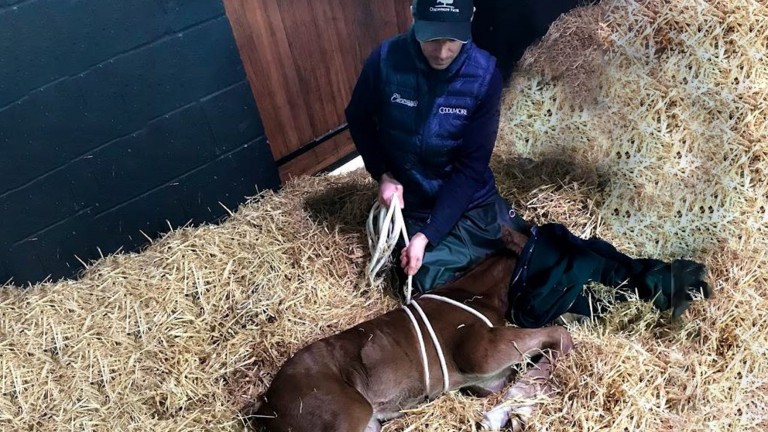Seasoned stud workers will likely know all about the modern method of treating ‘dummy foals’ – newly born horses that are dazed and disoriented and display no interest in suckling or bonding with their mother – but when I learned more about it recently it quite honestly blew my mind.
The technique, developed only around seven years ago and confirmed to be effective in a large-scale study last year, does not require any sophisticated item of technological equipment, nor any revolutionary pharmacological product.
Unbelievably, all it takes is a length of soft rope, used in quite the most ingenious way.
The breakthrough with neonatal maladjustment syndrome, as the disorder that affects around three to five per cent of thoroughbred foals is more properly known, was made by Professor John Madigan and his team at the University of California Davis in 2015.
It had long been believed that the problem was caused by the foals being starved of oxygen (hypoxia) during their birth, but they suspected that was unlikely, as it would cause permanent brain damage – and most newborns who suffer maladjustment syndrome actually recover with no long-lasting health issues, although they require long and costly intensive care.
They reasoned instead that the birthing process, and in particular the pressure applied to the foal while it is in the birth canal for what should be 20 to 40 minutes during the second stage of labour, functions as an ‘on switch’ that activates consciousness and the need to stand and nurse.
Their theory was supported by the fact that maladjustment syndrome was more common in horses that were born by caesarean section or experienced unusually rapid births.
Those foals also often had in their bloodstreams a higher level of the neurosteroid that acts as a sedative in the womb – a crucial tool for four-legged, hooved foetuses that could cause catastrophic damage to their mothers with too much movement.
Here’s where it gets astonishing, and that length of rope comes in.
Madigan and his researchers found that they could mimic the sensation of being in the birth canal by tying the rope around the newborn foal’s torso and gently squeezing it.
The process causes the foal to lie down and fall asleep, and after about 20 minutes the rope is loosened. Remarkably, it appears to trigger the same biochemical changes in the nervous system as a natural birth, and causes the foal to get to its feet and go over to the dam to suckle.
The novel procedure is now known as the Madigan Squeeze.
That’s more than enough of me trying to wing it on complicated medical issues. Far better to hear from a man who has put the theory into practice: Dr Pat Sells, who runs Orbital Veterinary Services from Chasemore Farm in Surrey.
“When I first heard about Professor Madigan’s squeeze treatment back in 2016, it instantly made more sense than the hypoxia theory,” he says. “Historically we’d been battling with these dummy foals for days on end, giving them oxygen, intravenous fluids, steroids and so on in an effort to treat presumed brain damage, and then after a week of intensive (and expensive) treatment they would suddenly come right.
“This didn’t fit with a brain or organ-damaged foal. Trying to encourage a dummy foal to drink from its mother’s bag is one of the most frustrating things in stud life – no matter the technique, it’s just not possible to get it to latch on and consume that vital colostrum, despite there being a strong suck reflex and plenty of milk.
“Inevitably the stomach tube would be reached for, but then a few hours later the phone would go again: ‘Pat, he’s still not drinking’. Now, however, the treatment is instantaneous.”
Thanks to the groundbreaking work of Madigan and his team, Sells’ clients on foaling duty call for what is mirthfully known as ‘Pat’s rope trick’.
“I have a long, soft white rope in the car that I use on any foal displaying the tell-tale signs of maladjustment – the cardinal one being lack of maternal recognition,” he says. “A series of nooses and slip knots is tied around the foal so that three loops pass snugly around the chest and abdomen, all meeting back at one point behind the wither.
“When I pull on this line the foal immediately sinks to the ground, lying flat out; I place a towel or jacket over his eye and ear to reduce stimuli, and everyone stays quiet. For 20 minutes I place enough traction on the line to gently squeeze the foal: we are literally recreating the birthing process."
Pat continues: “Madigan discovered that these ‘dummy foals’ were still under the effects of neuro-sedatives produced when the foal was in the womb to keep it peacefully sleeping. In the normal animal, production of these sedatives stops when the foal goes through the squeezing process of passage through the birth canal.
“In foals that are born too quickly (or sometimes, via caesarean section), this squeeze can be insufficient to trigger the hormone cascade. Hence the ‘rope trick’.
“When 20 minutes is up, I untangle the rope as the foal springs to its feet. It stretches as if coming out of a deep sleep, and then whickers to its dam. For the first time in its life, it looks at its mother and recognises her. The foal nuzzles its way to the bag and latches on. Relief! It’s literally that instantaneous, and intensely satisfying.”
And there’s yet more to this extraordinary story.
Pat explains: “The science behind this process, also documented in lambs and calves, has drawn scientists to make parallels with humans.
“The lack of social interaction seen in foals with neonatal maladjustment syndrome has led researchers to make links between this condition and autism seen in humans.
“Autism varies in its severity, but people with the condition often struggle to interact with others. Researchers at UC Davis are considering that similar neurosteroids seen in maladjustment syndrome are also implicated in autism.”
Maybe I’m going soft in my old age, but I find it profoundly moving to see mankind uniting in common cause, working tirelessly to find ingenious solutions to longstanding problems, as was the case with the development of the Madigan Squeeze. Especially when there are so many depressing examples of deplorable human behaviour in the world at present.


